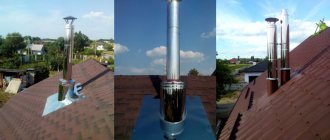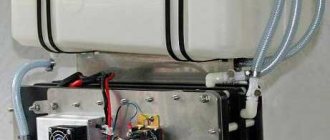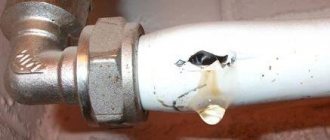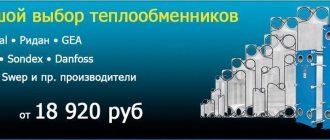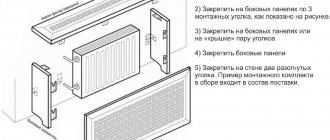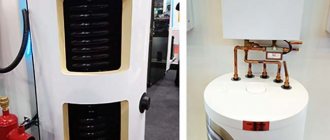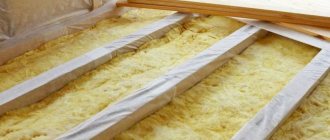What it is?
A heat exchanger is a device designed to exchange heat between two or more heat carriers not directly connected to each other.
Most often used to heat water directly from the heating system. This allows you to significantly save on heating and electricity, as it allows you to avoid spending additional energy on heating water, as is the case with an electric or gas water heater.
Theoretically, you can consider using water directly from the heating system, since its quality is not much different from water sold in supermarkets. However, in practice, it cannot be used for domestic purposes.
This is due to the following reasons:
Replacing water in heating pipes is a costly process and requires money.- The injection of new water has a negative effect on boilers and contributes to rapid wear of the system.
- Heating systems often use chemical additives to soften the water.
- The pipes in these systems themselves have a lot of deposits inside them; the standards for their use are designed for process water, and not for human consumption.
For the above reasons, it is not possible to use water directly from heating pipes for household and food purposes, and to heat water from a heating system, it is necessary to use a heat exchanger.
Heat exchanger design
Hot water systems use recuperative heat exchangers. That is, they transfer energy from one medium to another through a surface that prevents mixing during constant contact with it.
99% of DHW heat exchangers are water-to-water. That is, heat is transferred from water to water in them. Rarely - as a rule, for the internal needs of steam boiler houses, the water in the DHW system is heated by a steam-water heat exchanger (we will also describe it).
By the way, moving away from the topic of our article: At the same boiler houses and combined heat and power plants (CHPs), steam-water heat exchangers are used to heat network water, which is supplied to heating systems. The reason is that steam heating, due to the high temperature of pipes and radiators, as well as the burning of dust on them, is not allowed for residential and public buildings.
Heat exchangers are divided into two groups.
Flow-through
These are also almost all, with a few exceptions, heat exchangers used in hot water supply networks. In them, the flow of coolant, moving, also heats the moving flow of water for hot water supply.
Capacitive
In DHW, as a rule, in such heat exchangers, a moving flow of network water heats the water in a container, from which it is taken as needed. They are rarely seen. Such devices are not mass-produced.
The advantage of cylinder boilers is that they can provide a large volume of hot water for some time even with a low-power heating boiler. Flow heat exchangers cannot cope with this task. In tanks, water is constantly heated, and when you need to take a bath or shower, the required amount is taken from the tank.
The disadvantages of such devices are:
- large dimensions;
- lower efficiency compared to flow-through heat exchangers - part of the heat escapes through the walls of the container (and they have a larger area), even if it is thermally insulated.
If there is a need for more powerful DHW to operate in a mode similar to that of a capacitive heater, then most often a combination is used: a conventional flow-through hot water heat exchanger and an insulated battery tank in which hot water is accumulated.
Heat exchanger design
It is difficult to give an exact classification of structures; it may differ among different authors and sources.
But still, most often they are divided into the following groups:
- sectional;
- coil;
- shell-and-tube;
- ribbed;
- lamellar;
- lamellar-ribbed;
- cell phones
In hot water supply systems, in the vast majority of cases, only two types are used: shell-and-tube and plate. Let's look at them in more detail.
Shell and tube
Shell and tube heat exchangers brand GDP-1
In them, a bundle of pipes through which heated water circulates is located in a casing through which network water passes.
This choice is related to the following:
- DHW water consumption is less than network water consumption. Therefore, it is more profitable to run the latter through the interpipe space.
- Scale is usually formed from untreated water that we heat. It is easier to clean the internal surfaces of the beam than the external ones (we will find out why below).
Shell and tube heat exchanger drawing
The body itself is most often made of steel or cast iron, but the tube bundle is made of materials that conduct heat well, because heat exchange occurs through their walls. Therefore, they choose copper or brass, and in rare cases aluminum. But you can also find heat exchangers with steel pipes.
Water-to-water heat exchanger design
For even better heat transfer, they resort to other measures:
- They try to make the pipe walls as thin as possible. But the thickness is calculated so that they can withstand the working pressure.
- Increase the contact area between network water and heated water. To do this, the pipes are given a complex profile and equipped with ribs. The complex profile and ribs provide another advantage - near their walls, the water flow swirls and becomes turbulent (a smooth flow is called laminar). This increases the contact time of its volumes - and, therefore, improves heat transfer.
The types of pipes used in shell-and-tube heat exchangers are shown in the figure below:
Types of pipes used in shell-and-tube heat exchanger
- Increase the number of pipes in the bundle and place them as close to each other as possible.
- In order to increase the length of the bundle pipes in the casing, they are not placed in a straight line, but are curled into a spiral.
Note: However, all these tricks, in addition to increasing efficiency, also bring a problem - the heat exchanger becomes more difficult to clean. Therefore, half of the devices in use have smooth, straight pipes.
At the ends, the casings are closed with washers with holes for pipes; they are called: pipe plates or gratings. Moreover, to compensate for temperature deformations, the bundle pipes are not welded, but rolled (the same is done with pipes in boilers). Options for rolling and arrangement of pipes on the board are shown in the figure below.
Options for rolling and placing bundle tubes on tube sheets (grids)
As a rule, shell-and-tube heat exchangers for hot water supply systems are assembled from several sections, which makes it easier to modernize and repair the system. If necessary, reduce or increase power, simply change their number.
Heat exchanger assembled from several sections
The interpipe space of the sections, through which network water circulates, is connected by simple straight pipes. The space behind the tube sheets - U-shaped pipes, also called rolls. Sections are most often assembled vertically, one above one.
As we have already said, scale forms most of all on the internal surfaces of the bundle pipes. To clean it, thanks to this design, there is no need to completely disassemble the heat exchanger and disconnect it from the heating system. We simply turn off and drain the water from the hot water system, remove the rolls and clean the pipes.
Steam-water shell-and-tube heat exchanger
Steam-water heat exchanger
As we have already said, such a heat exchanger is less common and is most often used for the water supply needs of the steam boiler house itself or nearby houses that do not have their own boilers. Let's consider it too. A drawing of the most common type is shown below.
Steam-water boiler
Its design is very similar to the hot water heat exchangers we previously reviewed. The differences are as follows.
- The interpipe space is much larger, since heating of water for water supply occurs as a result of steam condensation - and this requires volume.
- The volume behind the left (according to the drawing) tube sheet is divided in two. Water is supplied to one half for heating, and hot water is taken from the second. That is, along half of the pipes it moves from left to right, and along the other half - from right to left.
- The volume behind the right grate is not divided; the water flows unfold in it.
- There is a pipe for supplying steam from above.
- The water formed as a result of condensation is taken from the lower pipe as the boiler fills. Most often it is returned back to the boiler for reuse.
- If ordinary boilers are rarely equipped with safety valves (which are activated at critical pressure, releasing it), then for a steam-water apparatus this is a required part.
- It is also necessary to install a pressure gauge or other pressure sensor on such a boiler.
Plate heat exchangers
Plate heat exchanger
This type of heat exchanger appeared in the thirties of the last century; they are younger than shell-and-tube devices. But, having been a little delayed at the start, today they are rapidly displacing their older brothers.
If thirty to forty years ago the overwhelming majority of hot water boilers were shell-and-tube, today almost all new systems are made with plate-type devices.
Water heating unit with plate heat exchangers
A drawing of such a heat exchanger and a diagram of water flows for various types of assembly are shown in the figure below. This is the most common herringbone design.
Plate heat exchanger and water flow diagram in it
They are a set of plates in which a profile of strokes is created by stamping (this is clearly visible in the photo below) for water. Moreover, they try to make sure that her path is as long as possible. There are four holes along the edges of the plates, two of which are connected to the passages, and two are not.
Plate for heat exchanger
The plates are assembled into a package using rubber or paronite gaskets in such a way that the cavities between them are connected through one hole.
It turns out to be a kind of “sandwich”:
- plate;
- channels through which network water circulates;
- plate;
- channels through which heated water circulates;
- plate;
- And. etc.
One of the options for the movement of water flows inside the heat exchanger
They also try to make the plates, like the tubes in shell-and-tube heat exchangers, as thin as possible, and whenever possible choose a metal that conducts heat well: copper, brass or duralumin. However, most plate heat exchangers are still steel.
Packs of plates and spacers are limited by thick steel compression plates and are compressed by studs and nuts.
Attention. When assembling, you should always ensure that the clamping is correct, so as not to damage the gasket with excessive force and not to warp the plate block.
There are also plate-fin boilers - in addition to stamped passages, they contain ribs to improve heat transfer and increase the cross-section of the channels. But their price is an order of magnitude higher, so they are extremely rare in hot water supply systems.
The advantages of such devices include:
- Compactness: a plate heat exchanger for hot water supply with equal power to a shell-and-tube heat exchanger takes up 2-3 times less space.
- You can easily increase or decrease power by adding or removing spacer plates. Shell-and-tube boilers have the ability to regulate power only in entire sections, which are connected to each other by rollers and pipes.
- Cheap repairs, replacing the plate and gasket costs a penny.
But there are also disadvantages compared to shell-and-tube ones:
- Plate heat exchangers cannot operate at high pressures.
- They are sensitive to water hammer.
- Plate heat exchangers have higher hydraulic resistance. In systems without forced circulation of network water, they may not work very correctly.
Plate heat exchanger leaking from high pressure
Connecting heat exchangers
Next, let's look at how heat exchangers are connected to the heating and hot water system. The three most common options are: Moreover, it does not matter which boilers are used - plate or shell-and-tube.
Connection without hot water recirculation
The simplest diagram for connecting a heat exchanger is shown in the figure below; it is usually used in the domestic hot water system of a small private house with an autonomous heating boiler.
Connection diagram for heat exchanger without hot water recirculation
It is done as follows:
- The heat exchanger is connected in parallel to heating devices. Moreover (we have already talked about this) network water is supplied to the inter-tube space of the shell-and-tube boiler. Plate devices have completely identical circuits, so it doesn’t matter which one is connected to the heating network.
- Cold water from the water supply is supplied to one of the pipes of the second circuit of the heat exchanger, and hot water is taken from the other.
- The water in the heat exchanger moves due to the pressure of the water supply.
This figure also shows the connection diagram for the hot water temperature regulator.
It is also as simple as possible:
- A temperature sensor is installed on the heat exchanger. In the diagram it is designated B3 and the number “5”. It can also be installed at the hot water outlet.
- The signal from it goes to the microcontroller. In this scheme, it also regulates the heating, but this is not important to us.
- Analyzing the data received from the sensor, the microcontroller gives commands to the electric drive of the valve (it is designated
 Y The drive is designated 9.
Y The drive is designated 9. - The valve is mounted on the return of the network water (the return is the pipeline in which water returns to the boiler - the line from the boiler is called the supply). Reducing water consumption lowers the temperature, increasing it raises it.
However, this connection scheme is not very convenient. If the pipelines are long enough, you will have to wait a long time for the cold water to drain and the hot water to flow. Therefore, hot water pipelines are usually looped and recirculation pumps are installed. Then the hot water constantly moves in a circle. A similar scheme is discussed below.
DHW recirculation pump
Connection with hot water recirculation
Connection diagram for a heat exchanger with hot water recirculation
If you have not yet come across heating network diagrams, then this diagram shows:
- T1 - supply of network water from the boiler.
- T2 - return of network water.
- T3 - hot water supply.
- T4 - hot water return.
- B1 - supply of cold water from the water supply.
These alphanumeric designations are generally accepted and are found on all diagrams of thermal systems.
Further numbers in the footnotes indicate:
- heat exchanger for hot water supply;
- temperature regulator (2.1 is a valve, 2.2 is a sensor that controls the valve);
- recirculation pump;
- water meter;
- device protecting the pump from dry running.
Valves and gate valves are indicated by two triangles facing each other at their vertices. If one of the triangles is shaded, then this is a check valve that allows water to flow in only one direction.
There are two of them in this scheme. One is installed after the water meter and the water supply connection so that the recirculation pump does not transfer hot water from the return to the water supply. The second check valve is located after the pump, and additionally protects it from dry running.
In this scheme, the returned hot water is mixed with cold water, which is not very beneficial.
Two-stage connection diagram
If hot water supply systems with a heat exchanger are designed for large amounts of water, then in order to reduce the size of the equipment, two-stage heating is used. This is how DHW is almost always installed for an apartment building with a centralized heating system.
Note: Often boilers work not even for one building, but for a group of them - then they are placed in central heating points (CHS).
The heat exchanger connection diagram for it is shown below.
Connection diagram of heat exchangers for two-stage water heating
The symbols in this diagram are the same as in the previous one. Its upper part is also similar to that previously discussed - the only difference is that it is not the water supply system that is connected to the hot water return (T4), but the supply from another heat exchanger (stage 1), to which the water supply system (B1) is connected. Thus, not cold water, but preheated water is mixed into the water circulating through the hot water system.
A valve to protect against crushing of the water supply with hot water is installed in front of the first stage. The temperature regulator is placed on the second stage.
What are the advantages of using the device?
The main advantages for which it is worth installing this device are:
- High efficiency . The heat exchanger is capable of supplying water at the optimal temperature to several places in the house at once.
- Economical. The device allows you to heat water directly from heating; there is no need to install a heater and waste additional electricity and gas.
- Small size . The device is quite compact and does not take up much space.
- Easy to install and use . The device is easy to install, does not require frequent maintenance, and is easy to clean.
Dependent heat supply system operating without a heat exchanger.
Individual heating point designed to operate in a dependent heat supply system without a heat exchanger
There are two heating schemes, or how to correctly say heat supply. A dependent heating system, with which we are all very familiar, is when a boiler, heating water, supplies it through pipelines directly to the heating devices - heating radiators in the apartment, bypassing the heat exchanger. Of course, in such a scheme there is a heating point, control and measuring instruments, and sometimes weather-dependent automation is installed. Only without a heat exchanger can we influence the temperature in the batteries, which means that in general in apartments we can only reduce the temperature.
For boilers in a boiler room, such a scheme is also not convenient, it requires large pumps, boilers and heating network pipes work like an accordion, which is why they constantly break, and it’s better not to remember about heat leaks and heat losses lost in this case. But at the initial stage, without installing a heat exchanger in the heating system, it turns out to be quite cheap, but not effective, the boiler room does not know how much heat everyone needs, and the consumer is not able to influence the production of heat for heating, hence the overheating and low energy efficiency of such a heating system without a separation heat exchanger.
How does the device work?
The way the device works is that it allows two independent systems to exchange heat with each other.
Depending on the specific type of device, the pipes are connected to each other by plates, or arranged in a special way , for example, a pipe with a heat carrier is located inside a pipe with a receiver.
The water heats up quickly without coming into direct contact with the heat source.
The device is connected to heating and water pipes. Water passes through the system and is heated by a heat source, and then arrives at the tap in a heated state.
Design and principle of operation of the heat exchanger
The principle of coolant movement in a plate-type heat exchanger
The design of a heat exchange device directly depends on its type. Modern heating devices consist of two pressure plates with holes to which additional pipeline elements are connected. The heat carrier and heat consumer also enter the device due to the presence of holes. The operating principle of the heat exchanger is quite simple; it can be considered using the example of a plate unit. The heat flow in such a device affects the corrugated layer in it, which gradually gains speed during operation.
After the first stage starts, the media begin to move towards each other on both sides to avoid mixing. Working channels are formed on plates located in parallel; during movement along them, heat exchange occurs in each medium, as a result of which heat escapes outside the unit. In home or bath plate units, internal flows can follow a single-pass or multi-pass scheme, taking into account the technical characteristics and specific conditions.
Before choosing a device, it is useful to read information about what a heat exchanger is needed for, learn about the types of unit, the rules for its installation and operation.
Kinds
Based on their design, devices of this class are divided into two main categories:
- tubular,
- lamellar.
For domestic needs, plate-type devices are used due to greater ease of use and efficiency, as well as easy transportation and installation. Among tubular devices in everyday life, as a rule, the shell-shaped version is used.
Lamellar
Plate type heat exchangers are a structure of plates installed parallel to each other and connected in a single housing . The heat carrier and heat receiver flow in separate pipes connected to communications on the front and rear panels of the device.
Plate heat exchangers are in turn divided into three groups:
Collapsible. In this version, rubber seals are used to ensure the tightness of the structure.
The advantages of collapsible heat exchangers are ease of installation and use.The downside is the regular need to replace rubber gaskets and sensitivity to aggressive substances.
- Soldered. The design of such devices is more durable and is made of steel. Unlike collapsible ones, they rarely require maintenance and are tolerant to any environment. The disadvantage is the large weight of the structure and the impossibility of disassembling it, resulting in more difficult transportation.
- Welded. Made from heavy metals, used only in industry.
Tubular
This type of device is used mainly in industry, and also as structural elements of air conditioners and refrigerators.
They are used less frequently for heating water, since to ensure the same efficiency as from the plastic type, such a device must be quite large in size.
The advantage of this type is its high resistance to any conditions and environments . A common design is when another narrower one is located inside one wide pipe. The heat carrier flows through the inner pipe, and the receiver flows through the outer pipe.
In turn, tubular exchangers are divided into several types:
Case-like. A large number of tubes connected in a lattice.
It is possible to connect several devices of this type to achieve greater efficiency.This type is most often used in everyday life among tubular exchangers.
- Twisted. The pipes are twisted together around a single core. It is a compact and quite effective option. A variation of this design are spiral heat exchangers, in which both channels wrap around a single partition.
- Irrigation exchangers are designed in a spiral shape. Water flows down the gutter. Mainly used in ventilation systems.
Types of heat exchangers
Heat exchange units can be of various types. Their difference lies in the method of transferring thermal energy. The following types of presented devices are distinguished:
- Mixing . In them, the transfer of thermal energy is carried out by mixing two working media . These devices are much simpler in design than surface devices. It is possible to use such units only if it is possible to mix heat carriers. This condition is the main disadvantage of mixing devices.
- Superficial . In them, energy is exchanged between working heat carriers through the walls of the separator . Such devices are divided into recuperative and regenerative. In recuperative systems , when thermal energy is transferred through the dividing wall, the heat flow moves in one direction at each point of the wall . of a regenerative heat exchanger that the heat carrier, when alternately touching the same surface, changes the direction of flow from time to time .
How to calculate a model for a specific building?
When selecting a specific device model, the following parameters must be taken into account:
- number of residents in the room;
- the volume of water required by one resident per day, the standard consumption rate is 120 liters per person per day;
- degree of heating of the coolant - in centralized heating systems the standard is heating equal to 60 degrees;
- whether the device will work around the clock, or whether it is planned to be turned off periodically;
- water temperature in pipes in winter;
- number of appliances consuming hot water;
- permissible percentage of water loss.
The performance of the device must be calculated for the winter season, when the most active use of hot water is implied. For accurate calculations and selection of equipment, you can contact supplier companies.
Reasons for heat exchanger failure
The period of operation is determined primarily by how the water in the city water supply is disinfected. In Russia, either pure chlorine or chlorine dioxide is used. When the water flowing through the copper tube heats up, it causes a violent chemical reaction. Copper chloride is inferior to pure metal in strength, and therefore fistulas appear quite quickly. The luckiest people are residents of cities where tap water is ozonated.
We recommend: Coaxial pipe for a gas boiler: types, features and installation diagrams
But there are still very few such settlements. The high cost of the modern solution does not allow us to count on the rapid spread of ozonation. Moreover, now manufacturers have begun to save in every possible way. And if previously troubles happened quite rarely with thick tubes of heat exchangers, now thin, low-quality copper is used everywhere. The service life of products has significantly decreased.
Technical selection criteria
When choosing a heat exchanger, it is necessary, first of all, to pay attention to such parameters as the design and power of the device, as well as its cost. When using a device with a water tank, the choice of a tank of suitable volume plays an important role.
Design
To heat water from the heating system, devices of various designs are used, differing from each other in heating speed and efficiency:
With a coil .
In this design, the function of the heating element is performed by a coil filled with water. The complex shape of the element significantly accelerates heating. The coil can be installed at the bottom of the tank, or vertically for more uniform heating.- With two coils . Two coils provide even greater efficiency and heating speed.
- For heat pump . It differs in the way it is connected to the heating system; it can also be equipped with a coil.
- Device with electric heater . An additional heater speeds up the heating process. This option is the golden mean between a conventional heat exchanger and an electric water heater.
Volume of the tank
An important factor that must be taken into account when choosing is the size of the tank:
- For small spaces, a tank of one hundred liters is suitable . This is a compact and economical option, the easiest to transport. It is worth remembering that a small volume of water retains heat for a much shorter time, so it will have to be heated more often.
- For most private homes, a tank with a volume of 200 liters is suitable . This is enough for several plumbing fixtures, and the temperature will remain for quite a long time.
- For large houses, a tank with a volume of 500 liters is suitable . Such tanks are also used in production. For most premises, such a large volume will be an unnecessary and uneconomical solution, since such a tank will require much greater energy consumption.
How to extend the life of a heat exchanger?
In order for the heat exchanger to work as long as possible, a number of specific recommendations should be followed:
- Install a filter on the tap water supply - this will prevent the accumulation of lime deposits inside the circuit and minimize the effects of corrosion.
- Clean the heat exchanger in a timely manner, especially for units that are not equipped with water filters. The part must be cleaned regularly once every 2 years, if there is filtration - once every 4-5 years.
- Do not use the maximum operating mode of the burner all the time.
When choosing a gas boiler for a house or apartment, take into account the fact that heat exchangers made of cast iron or copper are considered the most durable.
Household models and their prices
Currently, there are a large number of heat exchange devices on the market, differing from each other in type of design, heating rate, tank volume and cost.
Lamellar
Here are some popular models:
R-012-10-19 PROMTECHSERVICE .
The plates of this model are made of steel. Between the plates there are thermal pads that effectively transfer heat from the carrier to the receiver.The strength of the structure is ensured by the corrugated surface. Approximate cost of the device: 14,000 rubles.
- KAORI Z. Soldered version model. The flows are directed diagonally. The plates have a large heat transfer area. Durable and reliable model. Cost from 32,000 rubles.
- Innovita DHW . Budget solution, installed on a gas boiler or heating network. The model is intended for use with Innovita boilers. Cost from 8000 rubles.
Shell and tube
Below are popular models of shell-type heat exchangers:
- TNG-1.6-M8/20G-2-2-I . A popular model, often used in industry and at home. It has tube sheets and a vertical heat compensator. Price – from 9000 rubles.
- Shell and tube heater TTAI . The design consists of two tubes with thin walls of different diameters, one nested inside the other. Thin walls promote more efficient heat transfer. The device is compact and easy to maintain. Price – from 7500 rubles.
- Bowman 190 kW . Premium device. Titanium tubes with anti-corrosion coating are suitable for interaction with chlorinated and sea water. Can work for both heating and cooling. Price from 120,000 rubles.
Washing methods
There are simple variations that practically do not involve any expenses, there are budget ones with minimal investments, and professional ones - they cost much more, but are highly effective.
How to flush the secondary heat exchanger of a gas boiler in one way or another? And when is it logical to use them. It all depends on the volume of deposits.
In the simplest situation, mechanical cleaning is sufficient. The outside of the VT ribs are cleaned. The work uses any hard brush, spatula, scraper or cable. It is very important here not to damage the plates.
The second method is washing with a special composition. In practice, it is combined with the first method and follows immediately after it.
The part is placed in a container with an acid mixture. Type of acid used: hydrochloric or citric. Suitable proportions: 100 grams per 10 liters. Water.
Acids can be replaced with any anti-scale preparations. After 30-40 minutes, the VT is removed from the container. The remaining scale is carefully wiped off.
At the same time, the coil is also cleaned. A special steel brush is used here.
The third method is chemical. More aggressive substances are pumped through the VT using a special pump. It attaches to the pipes of the part.
We recommend: How to choose a hot water boiler (for heating)
Suitable tools for the job are shown in this table:
| Facilities | Description | Proportion to water: grams: liter | Water temperature | Product price (RUB) |
| Lemon acid | Popular folk remedy | 100 : 10-12 | 50-70°C | 50 – 1 sachet. |
| Thermagent Active | A versatile liquid with a powerful effect | 1 : 9 | 40-50°C | 1500 – 10 kg canister. |
| STEELTEX Cooper | One of the most effective preparations, but suitable for working with light alloy parts | 1:6 to 1:10 | 40-60°C | 1300 – 5 kg capacity |
| Detex | Concentrate with effective biological substances. Excellent cleaning of steel, cast iron and copper parts | 200-500 :10 | 40-50°C | 4900 – 10 l canister. |
| Hydrochloric acid | Effectively removes heavy scale | 100 : 10 | 50-70°C | 50 – 1 kg |
A hose is placed in the container with the mixture almost to the very bottom, one side connected to the VT, and the other to the pump. This creates the necessary circulation. The procedure lasts 30-40 minutes. Then the part is thoroughly washed with plain water.
The fourth method does not involve extracting the component. This is a hydrodynamic flushing of the secondary heat exchanger of a gas boiler. But it is carried out only by professionals. This requires special technology and compliance with safety criteria.
Its principle is to run a special composition through the boiler system under powerful pressure (1.5-2 bar). The work is done by a booster. Abrasive elements are added to the cleaning liquid.
This is the most effective method, gently removing all deposits and cleaning the part to a commercial appearance.
If you doubt the success of self-cleaning, you can order this service. All operations are carried out within a day. Their price tag is determined by the following factors:
- region,
- power and boiler modification,
- company's markup,
- the equipment and chemicals used.
In Moscow and the central region, clients pay about 3,500-9,000 for services. In St. Petersburg - 3,000 - 7,000 rubles. In other regions: 1700 – 4500 rubles.
Step-by-step instructions on how to make it yourself
You can construct a device for exchanging heat from the heating network to water with your own hands.
Tools and materials
To construct a plate heat exchanger with your own hands, you will need:
- welding machine;
- Bulgarian;
- stainless steel sheets - two corrugated, one flat. Thickness 4 mm;
- electrodes.
Manufacturing process
The entire manufacturing process of the device is divided into several stages:
- It is necessary to cut corrugated steel plates. You will need 31 plates measuring 300 by 300 mm.
- A strip 18 meters long and 10 mm wide is cut from a flat sheet. The tape must be cut into pieces 300 mm long each.
- Squares of corrugated material are welded to each other with a ten-millimeter strip from different sides, adjacent sections must be perpendicular. You will get 15 sections facing one way and 15 the other in the form of a cube.
- A flat stainless steel manifold must be welded to the parts where water will flow.
- A hole is drilled in each collector, and the connecting part of the pipe is welded to it.
- The structure is mounted with the open side facing the gas system.
Advantages and disadvantages
Modern units are easy to maintain and do not cause problems during disassembly and washing of the device. Plate heat exchangers, which are most often installed, become dirty more slowly due to increased turbulence and high-quality polishing.
Heating units from leading manufacturers last longer than water boilers, hot water boilers and furnaces for homes and garages. The average service life of the unit is about 10-20 years. Most devices have virtually no drawbacks, except for the need to clean the device as it gets dirty. To reduce the accumulation of dirt inside the device, you should always use high-quality coolant.
Connection diagrams
The heat exchanger can be connected to heating and water supply systems using three different schemes: parallel, two-stage mixed and two-stage sequential.
Parallel
The most simple to implement and economical scheme . A prerequisite is the installation of a temperature regulator. The disadvantages are not the most economical consumption of carrier heat, as well as the need for an enlarged pipeline.
Two-stage mixed
Also requires a temperature controller. Significantly more economical than a parallel circuit in terms of heat consumption. However, the design itself is more expensive, since it requires two heat exchangers at once. Equipment must be selected very precisely in accordance with specific conditions.
Two-stage sequential
With this connection, the incoming flow is divided into two, one passes through the regulator, and the second through the heater. The heat carrier is consumed more efficiently compared to the mixed one. The load on the network is also distributed more efficiently.
The disadvantage of the scheme is the impossibility of full automation . Despite all the advantages, in practice the scheme is rarely used due to the strong influence of the heating and plumbing systems on each other and the possibility of overheating of the heating network.
Selection rules
Types of coolants used for heating systems
The list of main criteria that you need to pay attention to when choosing includes:
- type and quality of the thermal fluid used;
- ease of disassembly and assembly;
- type of heat transfer;
- the ability to increase the amount of power during operation.
Plate exchangers are more often used for cooling and heating systems of refrigerators and swimming pools, spiral exchangers are used in various industries, horizontal ones are better suited as heating devices.
How to use?
There are two main options for using a heat exchanger to heat water:
- The first option is to heat running water. The disadvantages of this method are limited water consumption, difficulty maintaining heat, and lack of water reserves. Pros: the system is compact.
- Heating in the container. The heat exchanger is immersed in the tank and filled with water. The design allows you to maintain the temperature for a long time, while there is always a supply of water. The disadvantage of this method is that the large dimensions of the tank require a lot of space.
Everything you need to know about hot water is presented in this section of the site.
Popular manufacturers
Aster heat exchangers of domestic production
In the Russian market, collapsible and soldered heat exchangers from the RIDAN and ASTERA brands have proven themselves well, characterized by a high level of quality and availability of the necessary spare parts.
Among foreign brands, buyers more often choose diesel and standard devices from ALFA LAVAL, DANFOSS and SONDEX.
When choosing a unit, you need to take into account the features of the system as a whole, the estimate, if we are talking about a project, requirements for the number of kW, as well as other necessary parameters.
Heat exchanger plates
The plate heat exchanger for heating a house is made of stainless steel. This metal perfectly withstands the negative effects of poor quality water. It can be affected by elevated temperatures that form in the combustion chamber. That is why the manufacturers made the right choice.
The described heat exchanger for heating is manufactured by stamping. The plates are not made from any stainless steel. There are special brands that are recommended for use. For example, domestic manufacturers most often use steel grade 08Х18Н10Т.
The plates have an interesting structure. They use a technology that involves creating grooves on top of a plane. They can be located symmetrically. Such a relief surface increases the area of heat removal and also guarantees uniform distribution of water.
How to avoid mistakes
The central coolant cannot be directly connected to heated floors, as this can damage them in a short time. Such consequences can be caused by certain reasons such as high pressure in central heating networks and high temperatures. In addition, the coolant contains a lot of dissolved iron and chemical reagents.
Plate Heat Exchanger Design
The heat exchanger for heating a private house can be plate-type. In this case, it includes:
- movable plate;
- fixed plate;
- fasteners;
- set of plates;
- top and bottom guides.
Fasteners are needed to tighten the slabs that form the frame. As for the guides, they have a round cross-section. Heat exchangers for heating can have frames of various sizes. Everything will depend on the power of the structure. The more plates, the greater the device's performance, as well as its weight and size.
The number of plates for a heat exchanger model has a certain indicator. They are designed with gaskets that seal the channels through which water flows. In order to achieve the required density of the two rubber gaskets, the plates are pulled together and fixed to a fixed plate.
Making a heat exchanger with your own hands
It is not always possible to buy a ready-made furnace project with a heat exchanger. Also, not everyone can weld themselves. But building a heat exchanger for a heating stove with your own hands is not such a difficult task. By using aluminum or copper you can avoid welding work. With good preparation and correct calculations, this is possible and not burdensome. In addition, it saves the family budget.
Consumables
Having chosen the location and size, it is worth considering what is easier to build a heat exchanger from. You can use both the materials listed above and cast iron radiators, car radiators, and the like. The main thing is to correctly take into account thermal conductivity. Think through exactly what tool you will need and prepare it in advance. All these little things will make installation easier.
Assembly algorithm
You need to start with the project - thinking through the little things and selecting options. It is worth starting from the size - if the stove is weak, then a disproportionately large heat exchanger will only do harm. If you use copper as a pipe for the coil, then the length should not exceed three meters.
The simplest manufacturing option is a coil. It will require a copper pipe from 2 m to 3 m long.
The heating rate depends on the length of the pipe and the number of turns. But it’s worth remembering that you need to take into account the size of the stove and firebox and not overuse the enlargement of the coil. Distortions in size reduce the service life of the furnace.
To twist the pipe into a spiral, you need a template. This is any cylindrical auxiliary part. The diameter of the template must fit into the combustion chamber size.
Having prepared the materials, let's start:
- Bending the pipe, we wind it onto a prepared blank to obtain a spiral;
- We observe the dimensions in which the coil must be placed;
The average design power of the heat exchanger is 1 kW per 10 meters of area.
If you are not satisfied with this type of heat exchanger, you can make another type, for example by welding steel pipes. It looks something like this:
Examples of drawings on which to carry out work:
How to install?
It is convenient to install a heat exchanger in a stove when laying a new stove. This will allow it to be completely installed, observing all the gaps and dimensions. With this installation it is easier to maintain the correct size. Having mounted the heat exchanger on the foundation of the furnace, it is easier to cover it with bricks than disassembling the finished furnace and trying to fit it into place. But this is also possible.
There are also important points and requirements that should be observed to increase service life:
- Do not fix structural pipes with metal fasteners;
- Do not fill with ice water to avoid condensation;
- maintain the proportions between the furnace and the heat exchanger, avoiding large differences;
- use sealing materials with high heat resistance;
- fully comply with all fire safety measures;
Simple rules will help you avoid dangerous situations and help extend the life of the stove. Don't forget about fire safety.
Examples of installation in the photo:
 Y The drive is designated 9.
Y The drive is designated 9.